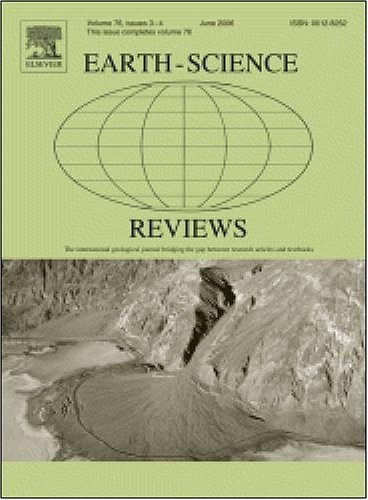中国非海相含油气盆地沉积岩中湖沸石的特征、成因及意义
IF 10
1区 地球科学
Q1 GEOSCIENCES, MULTIDISCIPLINARY
引用次数: 0
摘要
laumonite是一种富含钙的沸石,通常作为自生矿物出现在沉积岩中。由于其特殊的形成条件和在酸性环境下的高不稳定性,为分析中深层沉积—成岩体系和识别优质储层提供了重要的地质标志。本文综述了准噶尔盆地、鄂尔多斯盆地、四川盆地等中国典型非海相盆地沉积岩中泥沸石的分布、赋存状态、化学组成、成因、控制因素及其对油气成藏的影响。前人的研究表明,在垂直叠合的三角洲水下分流河道中,湖沸石通常以连续或块状胶结物、裂缝充填物和替代产物的形式发育。富含斜长石或火山物质的砂岩被认为是形成湖沸石的理想寄主岩。在成岩作用(<85°C)期间,湖沸石广泛填满粒间孔隙,单个晶体通常表现出长棱柱状习性,通常与粘土矿物、石英和榴辉石伴生。在中成岩过程中(85-175℃),湖沸石以斑片状的粒间填充物形式出现,单个晶体逐渐发育成短棱柱形形态,主要与方解石、伊利石、石英和钠长石伴生。沉积岩中的烟蒙岩具有典型的低Si/Al比值(2.00-2.20),其化学成分不随温度和产状发生系统变化。湖沸石的形成机制包括斜长石的岩化、火山物质的转化和早期沸石的蚀变。斜长石的不完全转化可能导致硅铝比偏高。流体包裹体均一温度数据表明,沉积岩中的湖沸石主要形成于60-140℃的温度范围内。斜长石和火山物质向烟熏云母的转化可以贯穿这段时间,而斜长石向烟熏云母的蚀变通常需要90°C以上的温度。高pH、低pCO2和富ca孔隙流体是控制烟云母形成的关键因素,而Na+的存在降低了烟云母形成反应的平衡温度。早期形成的湖沸石虽然占据原生孔隙,但也有助于抗压实。由于其发育良好的解理和较大的内部孔隙体积,钙长石比钾长石、钠长石或其他铝硅酸盐更容易在酸性流体中溶解。其溶蚀带为油气聚集提供了有利的环境。此外,沸石晶体内部的空腔具有较大的比表面积,这使得甲烷分子具有很强的物理吸附能力。本文章由计算机程序翻译,如有差异,请以英文原文为准。
Characteristics, genesis, and significance of laumontite in sedimentary rocks of non-marine petroliferous basins in China
Laumontite is a calcium-rich zeolite that typically occurs as an authigenic mineral in sedimentary rocks. Due to its specific formation conditions and its high instability in acidic environments, laumontite provides a key geological indicator for analysing sedimentary-diagenetic system and identifying high-quality reservoirs in middle-deep strata. This study offers a comprehensive review of the distribution, occurrence, chemical composition, genesis, controlling factors, and the impacts on hydrocarbon reservoirs of laumontite in the sedimentary rocks of typical non-marine basins in China, such as the Junggar Basin, the Ordos Basin, and the Sichuan Basin. Previous research indicates that laumontite commonly develops as a continuous or patchy cement, fracture filling, and replacement product within vertically stacked deltaic subaqueous distributary channels. Sandstones enriched in plagioclase or volcanic material are considered ideal host rocks for laumontite formation. During eodiagenesis (<85 °C), laumontite extensively fills intergranular pores, with individual crystals typically exhibiting a long prismatic habit, and commonly occurring in association with clay minerals, quartz, and heulandite. During mesodiagenesis (85–175 °C), laumontite occurs as patchy intergranular fillings, with individual crystals progressively developing a short prismatic morphology, and is mainly associated with calcite, illite, quartz, and albite. Laumontite in sedimentary rocks is typically characterised by a low Si/Al ratio (2.00–2.20), and its chemical composition shows no systematic variation with temperature or occurrence. Formation mechanisms of laumontite include the albitisation of plagioclase, transformation of volcanic material, and alteration of early-formed zeolites. Incomplete transformation of plagioclase may result in a higher Si/Al ratio in laumontite. Fluid inclusion homogenisation temperature data indicates laumontite in sedimentary rocks primarily forms within a temperature range of 60–140 °C. The transformation of plagioclase and volcanic material to laumontite can proceed throughout this interval, while alteration of heulandite to laumontite generally requires temperatures above 90 °C. High pH, low pCO2 and Ca-rich pore fluids are key factors controlling laumontite formation, while the presence of Na+ lowers the equilibrium temperature of laumontite-forming reactions. Although early-formed laumontite occupies primary pores, it also contributes to compaction resistance. Owing to its well-developed cleavage and large internal pore volume, laumontite dissolves more readily in acidic fluids than K-feldspar, albite, or other aluminosilicates. Its dissolution zone provides a favourable environment for hydrocarbon accumulation. Additionally, the internal cavities within laumontite crystals possess a large specific surface area, which enables strong physical adsorption of methane molecules.
求助全文
通过发布文献求助,成功后即可免费获取论文全文。
去求助
来源期刊

Earth-Science Reviews
地学-地球科学综合
CiteScore
21.70
自引率
5.80%
发文量
294
审稿时长
15.1 weeks
期刊介绍:
Covering a much wider field than the usual specialist journals, Earth Science Reviews publishes review articles dealing with all aspects of Earth Sciences, and is an important vehicle for allowing readers to see their particular interest related to the Earth Sciences as a whole.
 求助内容:
求助内容: 应助结果提醒方式:
应助结果提醒方式:


